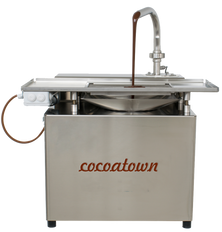THE EVOLUTION OF CHOCOLATE
By Rochelle Myers News-Post Staff | May 19, 2010 | fredericknewspost.com
From beans to bars to bonbons

GAITHERSBURG — Chocolate comes from the cacao bean. This is a basic fact, but it’s hard to imagine that this bean — or any bean — can be transformed into the rich, bitter, sweet, passion-inflaming substance we call chocolate.
Most of us never see this process; there are few chocolatiers who actually make their chocolate from a bean.
I recently attended a small chocolate-making conference for serious amateur and professional enthusiasts. The conference was held at L’academie de Cuisine in Gaithersburg and was organized by members of the eGullet Society for Culinary Arts and Letters.
About 30 people gathered on a spring weekend to talk about all the aspects of making fine chocolates: the bean-to-bar process, building flavor in ganache-type fillings, decorating, panning, molding, filling, displaying and, of course, eating.
Mary Bracey pours ganache
at a chocolate-making
conference in Gaithersburg
recently.
The part of this conference I was most excited about was the presentation by Balu Balasubramanian of CocoaTown LLC. Balasubramanian brought a grinder that has been engineered for the purposes of grinding cacao beans into chocolate, which sat on the counter whirring merrily while he talked.
“Chocolate today is like the microbrewery or coffee industries — it’s in the early stages of the same transformation,” he said.
The machines he sells allow professionals and passionate amateurs to make their own chocolate from scratch, controlling the source of the beans and the nature of the additives that make the resulting chocolate palatable.
Cacao beans must be roasted and cracked and the husks removed before grinding the nibs into chocolate liquor — a process described and photographed in great detail at www.chocolatealchemy.com.
Balasubramanian focuses on the grinding process, but there are a few other steps required on the road from bean to bar.
The CocoaTown grinders are adapted from Indian machines used for turning grains and beans into flours and pastes. Chocolate cannot be produced by simply whirring cacao beans in a food processor until pulverized; a grinder designed for making chocolate will slowly and gently shear and smooth the beans into chocolate liquor over the course of 24 to 48 hours. These grinders are designed to work for such long periods without overheating.
Additives such as sugar, lecithin and flavorings can be added to the grinder; they are combined with the chocolate liquor during the grinding process, so the finished product is “conched” and ready to turn into chocolate bars.
Balasubramanian passed around some almond paste that had been made in a CocoaTown grinder. The paste was unlike any product I had tasted elsewhere — it had a fresh flavor and a texture that was a little sandy, like the texture of the inside of a Reese’s peanut butter cup.
After Balasubramanian finished talking about the CocoaTown grinders, area chocolatier and conference organizer Steven Lebowitz of Olney led a discussion about building flavors in chocolate fillings.
“It doesn’t matter if it looks good if it doesn’t taste good,” he said.
He shared a handout that included grids showing how flavors match with different types of chocolate. Most people are familiar with flavor pairings such as raspberry with white chocolate or hazelnut with milk chocolate. The people at the conference were interested in questions such as what type of chocolate to pair with lemongrass, thyme, anise and bacon.
The different flavors added to a chocolate truffle filling can have a significant effect on the chocolate’s shelf life. Lebowitz described different additives, ranging from common ingredients, such as alcohol, to special-order products, such as xylitol, that can extend the shelf life and preserve the fresh flavors and textures of chocolates. (The xylitol has a slightly diuretic effect, so it may not be the best choice for preserving a chocolate.)
After the discussion about flavoring and preserving chocolates, the conference attendees moved into a large kitchen to begin putting the lessons of the morning into practice. Large chocolate melters were filled with different types of tempered chocolate. An array of flavors — essential oils, common and exotic herbs, spices, vanilla beans — beckoned from a center table.
Some attendees worked on decorating molds for molded truffles, using techniques such as handpainting and airbrushing with colored cocoa powder. Chocolates are also decorated with “transfer sheets” — plastic sheets with designs printed in colored cocoa butter. Kerry Beal of The Chocolate Doctor demonstrated the transfers on some chocolate-dipped Oreo cookies to impressive effect.
Others practiced “panning” chocolate treats. Panning is the method used for making confections such as chocolate-covered peanuts. The center — a nut, a coffee bean or whatever is to be coated — is placed in a rotating drum. Tempered chocolate is added and the center rolls in the chocolate, gradually building up a chocolate coating. Art and Wilma Wills of Chocolate F/X commandeered the panner, patiently showing how they make confections such as chocolate “gemstones” and chocolate-covered dried Michigan cherries.
There were many technical discussions during the conference, but I came to see how cacao beans are turned into chocolate. And I was rewarded with far more — a chance to see the techniques used for flavoring exquisite chocolates, and a peek at the methods used for making the finished product shiny, beautiful and appealing. The opportunity to taste some of the finished products was an added bonus. I felt fortunate to have seen these techniques in action such a short distance from Frederick County — a rare opportunity to visit the world of professional and passionate amateur chocolate arts.
Rochelle Reid Myers caters and teaches private cooking classes. Her website is www.myersfood.com. She also maintains a food blog at www.lotsofeverything.com Follow her on Twitter at @RochelleMyers.
Published by Rochelle Myers News-Post Staff | May 19, 2010 | fredericknewspost.com

